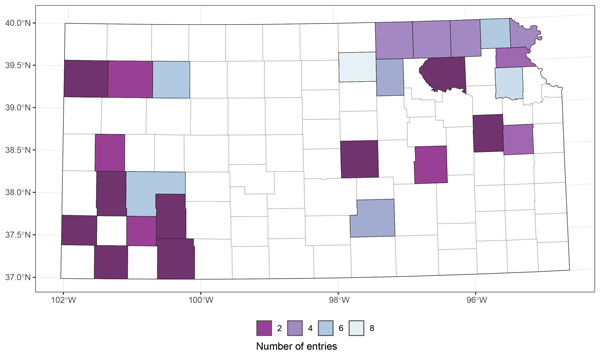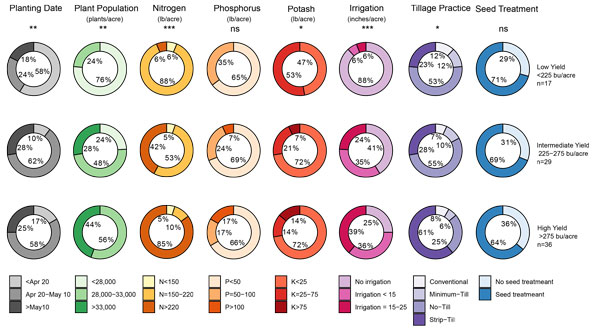The Kansas Corn Growers Association, with K-State Research and Extension, conducts an annual yield contest open to all active members of the association. This contest:
- recognizes Kansas farmers achieving high corn yields,
- shares crop management and efficiency data among Kansas growers, and
- provides on-farm sustainability and profitability insights. This document summarizes the 82 entries from 2022 (Figure 1).

Figure 1. 2022 contest field locations, 82 total entries (irrigated=46; non-irrigated=36). Map from KSRE publication MF3463.
Summary of results
Yield
- Grain yields for irrigated entries averaged 278 bushels per acre, ranging from 217 to 324 bushels per acre. Non-irrigated entries averaged 236 bushels per acre, ranging from 163 to 309 bushels per acre.
- Grain yields for high-yielding environments averaged 293 bushels per acre, ranging from 276 to 324 bushels per acre. Intermediate-yielding environments averaged 255 bushels per acre, ranging from 225 to 275 bushels per acre. Lastly, low-yielding environments averaged 197 bushels per acre, ranging from 163 to 224 bushels per acre.
Crop Management
- Planting dates before April 20 presented significantly lower yields compared to later dates. Related to this, 58% of the low-yielding entries were planted before April 20.
- Plant populations ranged from 23,000 to 38,000 plants per acre. Yield increases were significantly tied to greater plant populations, showing an increase of 10.5 bushels per acre for every 1,000 plants per acre until a plant population level of around 32,500 plants per acre.
- Relative to nutrient management, corn yield increased by 0.4 bushels per acre for every pound of nitrogen (N) added. No clear trends were found for the application of phosphorus (P) or potash (K). A higher percentage of K fertilization was observed in the low-yielding entries.
- Irrigation significantly explained yield variations. Three-fourths of the irrigation observations were concentrated in the high-yielding entries.
- Strip-tillage was the most common tillage practice (66%) among the high-yielding group. Conservation tillage (strip and minimum) and no-till were common across all entries. Conventional tillage represented only 7 to 12% of the entries.
- Seed treatment did not result in a yield increase.
- The row spacing ranged from 15 to 39 inches. 84% of the entries were planted in 30-inch rows.
Key Points
- The entries presented, on average, 5% less yield than the 2021 entries.
- Planting after April 20, with plant populations near 30,000 plants per acre and fertilizer nitrogen rates of about 250 pounds per acre maximized yields.
- Irrigation to supplement rainfalls (at least 5 inches) was fundamental to achieving higher yields.
- The results are linked to the climatic conditions of the 2022 growing season, which was characterized by limited water.
- Planting date, plant population, N and K fertilization, irrigation, and tillage practice were the most significant factors explaining yield levels.

Figure 2. Data summary for the crop (irrigation and yield environment) and pest and nutrient (yield environment) management of contest entries. Significant differences are indicated with symbols: ***p<0.001; **p<0.01; *p<0.05, ns means not significant at p<0.05.
This information is also presented in the KSRE publication MF3463 Kansas Corn Yield Contest, High-Yield Management at https://bookstore.ksre.ksu.edu/pubs/MF3463.pdf
Ana Carcedo, Postdoctoral Research Fellow – Ciampitti Lab
carcedo@ksu.edu
Ignacio Ciampitti, Farming Systems
ciampitti@ksu.edu